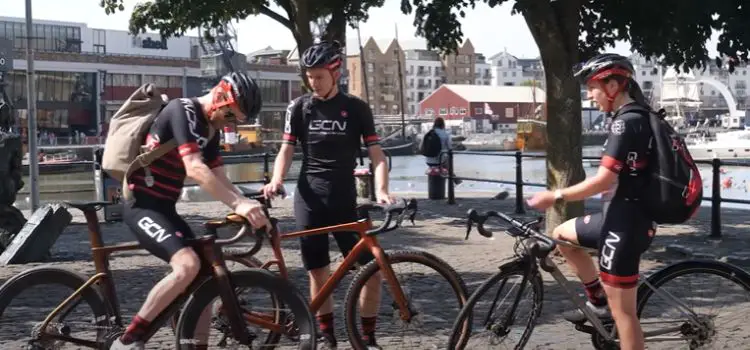Trek vs. Specialized Road Bikes: A Detailed Comparison!
As an Amazon Associate I earn from qualifying purchases.
In the vast universe of road cycling, two giants stand tall, each boasting a rich history, innovative technology, and a legion of devoted riders. Trek and Specialized, both American-born brands, have established themselves as leaders in the competitive realm of road bikes.
For enthusiasts seeking the perfect steed to conquer the asphalt, the Trek vs. Specialized debate is as timeless as the joy of riding itself.
In this comprehensive exploration, we’ll delve into the intricacies of both brands, comparing their histories, manufacturing philosophies, and the standout features of their road bike lineups.

Founding Stories: Trek’s Barn Beginnings vs. Specialized’s Italian Connection
The birth of a brand often sets the tone for its identity and trajectory. Trek’s story unfolds in 1976, when Richard Burke and Bevil Hogg established the company in a humble barn in Waterloo, Wisconsin. With a background in appliance distribution, Burke’s foray into the world of bicycles was marked by a desire to fuse innovation with a touch of historical charm.
On the other side of the spectrum lies Specialized, founded by Mike Sinyard in 1974, two years before Trek’s inception. Sinyard’s early endeavors involved importing Italian bike parts, an adventure that ultimately inspired him to delve into manufacturing. By 1981, Specialized was crafting its own bikes, with the iconic Allez road bike marking the beginning of an illustrious journey.
Manufacturing Odyssey: Trek’s Global Touch vs. Specialized’s Asian Alliance
The manufacturing origin of a bike often sparks curiosity among enthusiasts, especially in an era where the global landscape influences production. Trek and Specialized both engage in significant overseas manufacturing, reflecting the industry’s trends.
Trek, with its roots firmly planted in the U.S., embraces a global approach. While the company’s headquarters remain in Wisconsin, a significant portion of its production takes place overseas. Approximately 10,000 high-end Trek bikes are manufactured in the U.S., with a mix of production locations including China, Holland, and Germany.
Specialized, on the other hand, has a strong alliance with Asian manufacturers. All specialized bikes, as per available information, are crafted in Asia, with key suppliers being Merida, Giant, and the intriguingly named ‘Ideal.’ 49% ownership by Taiwanese firm Merida since 2001 adds a unique global dimension to Specialized’s production strategy.
Model Rundown: Trek’s Domane, Emonda, and Madone vs. Specialized’s Allez, Roubaix, and Tarmac
The heart of the comparison lies in the road bike models offered by each brand, each catering to different riding styles and preferences.
Trek’s Road Bike Range:
- Aluminium (Beginner/Budget): Comprising aluminum versions of the Domane and Emonda, Trek’s entry-level road bikes aim to provide a solid foundation for novice riders.
- Endurance (Relaxed Fit): The Domane series embodies the endurance category, catering to those seeking a more comfortable ride without sacrificing performance.
- Lightweight (Racey Climby): The Emonda series, designed for lightweight efficiency, appeals to riders yearning for speed on climbs and responsive handling.
- Aero Road (as opposed to Pure Aero): The Madone series merges aerodynamics with road versatility, offering a balanced solution for riders seeking speed without compromising agility.
- Gravel (Adventure): For adventurers, Trek presents the Checkpoint, Boone, and Crockett series, embracing the burgeoning gravel biking trend.
Specialized’s Road Bike Range:
- Aluminum (Beginner/Budget): The Allez series serves as Specialized’s entry point, providing affordable yet reliable options for those entering the road biking arena.
- Endurance (Relaxed Fit): The Roubaix series, true to its name, caters to endurance enthusiasts, promising a comfortable ride reminiscent of the iconic spring classics.
- Lightweight (Racey Climby): The Tarmac series embodies lightweight efficiency, designed for those who revel in the thrill of climbing and swift accelerations.
- Aero Road (as opposed to Pure Aero): Specialized’s Venge series brings aerodynamics to the forefront, offering a specialized solution for riders focused on speed and efficiency.
- Gravel (Adventure): The Diverge series invites riders to explore unbeaten paths, embracing the call of adventure on gravel terrain.
Decoding Naming Conventions: Trek’s Numbers and Letters vs. Specialized’s Climbing the Spec Tree
Understanding how each brand denotes the hierarchy of its models is crucial for potential buyers seeking the perfect fit.
Trek’s Model Naming
Trek uses a combination of numbers and letters to signify different specifications and features. Higher numbers generally denote higher-spec’d bikes. For instance, the Domane SL 5 features a Shimano 105 groupset, while the SL 6 boasts an Ultegra groupset. At the top tier, the SLR 9 showcases full Shimano Dura-Ace Di2 electronic gear.
The ‘SL’ designation often indicates Trek’s lower-priced bikes, standing for ‘Super Light.’ At the upper echelon, the ‘R’ is added, as seen in SLR (Super Light Race), highlighting key differences in frame construction, such as adjustable resistance settings on the Isospeed’s suspension’ for the SLR versions.
Specialized’s Model Naming
Specialized keeps things relatively straightforward in its naming conventions. Basic versions carry the name of the series, like the Roubaix. As riders ascend the specification tree, suffixes indicate the level of specification:
- Sport
- Comp
- Expert
- Pro
At the pinnacle, Specialized unveils an ‘S-Works’ version of each bike, featuring advanced specifications. Notably, the ‘S-Works’ prefix comes at the start, as in ‘S-Works Roubaix.’
Visual Feast: Exploring Trek and Specialized’s Road Bike Aesthetics
For many cyclists, aesthetics play a significant role in the bike selection process. Both Trek and Specialized offer visually stunning road bikes that combine form and function.
Trek’s Aesthetic Appeal
The Trek website showcases the full range of road bikes, inviting enthusiasts to a visual feast. As a proud owner of a Trek Domane, the allure of the new Emonda, with its sleek design, is hard to resist. The gold accents add a touch of luxury, tempting riders to embark on a journey of elegance and speed.
Specialized’s Visual Symphony
Specialized’s website is a gallery of road bike masterpieces, with the S-Works Tarmac standing out as a visual symphony. The intricately designed frame, coupled with high-end components, creates an ensemble that beckons riders to revel in the thrill of speed and precision.
Conclusion: The Saga Continues
As we wrap up this exploration into the Trek vs. specialized road bike saga, it’s clear that each brand brings its own unique strengths to the table. The choice between a Trek and a Specialized ultimately boils down to personal preferences, riding styles, and the specific features that resonate with individual cyclists.
The road ahead promises exciting twists and turns, with future comparisons delving into specific bike categories, further unraveling the intricacies of two iconic brands. Whether you find yourself drawn to the endurance prowess of Trek’s Domane or the aerodynamic marvel of Specialized’s Venge, one truth remains: the joy of cycling knows no bounds, transcending brands and boundaries alike. So, saddle up, dear riders, for the adventure of a lifetime awaits, guided by the wheels of innovation and the spirit of exploration.
In the eternal duel of Trek vs. Specialized, may the road rise to meet you and the wind be ever at your back.
Ride on.
Amazon and the Amazon logo are trademarks of Amazon.com, Inc, or its affiliates.






